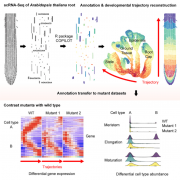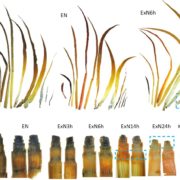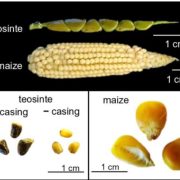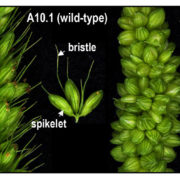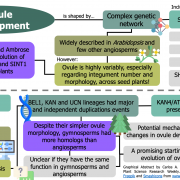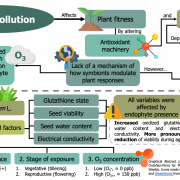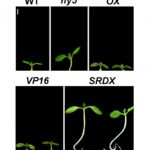Two MYB proteins in a self-organizing activator-inhibitor system produce spotted pigmentation patterns (Curr. Biol.)
 The questions of how patterns are formed is one of the oldest in biology, and even considered by the famous mathematician Alan Turing, who proposed that reaction-diffusion (RD) models underly de novo pattern formation. Briefly, a reaction that takes place in one place sends a signal that leads to a different effect. A new paper identifies two genes involved in a RD model for the origins of pollinator-attracting nectar guides in the monkeyflower Mimulus spp. NECTAR GUIDE ANTHOCYANIN (NEGAN) is a MYB transcription factor in monkeyflower necessary for anthocyanin deposition in nectar-guide spots. In this new work, the authors speculated that the spots could be generated through a Turing-type RD pattern generator. Through a genetic screen for plants in which the entire nectar-guide region was red (rather than spotted), they identified a mutant in a MYB-encoding gene that they named RED TONGUE, with a function of inhbiting anthocyanin production. They also found natural variants with the same phenotype caused by the same gene in a related species, Mimulus guttatus. NEGAN activates expression of RTO (consistent with an RD mechanism). Furthermore, RTO is a negative regulator of NEGAN function that moves between cells. Computer simulations confirm the potential of this gene pair to produce localized spots of anthocyanin. Finally, the authors also found allelic variation in wild populations, and showed that the corresponding phenotypic variation is capable of affecting pollinator visits. (Summary by Mary Williams) Curr. Biol. 10.1016/j.cub.2019.12.067
The questions of how patterns are formed is one of the oldest in biology, and even considered by the famous mathematician Alan Turing, who proposed that reaction-diffusion (RD) models underly de novo pattern formation. Briefly, a reaction that takes place in one place sends a signal that leads to a different effect. A new paper identifies two genes involved in a RD model for the origins of pollinator-attracting nectar guides in the monkeyflower Mimulus spp. NECTAR GUIDE ANTHOCYANIN (NEGAN) is a MYB transcription factor in monkeyflower necessary for anthocyanin deposition in nectar-guide spots. In this new work, the authors speculated that the spots could be generated through a Turing-type RD pattern generator. Through a genetic screen for plants in which the entire nectar-guide region was red (rather than spotted), they identified a mutant in a MYB-encoding gene that they named RED TONGUE, with a function of inhbiting anthocyanin production. They also found natural variants with the same phenotype caused by the same gene in a related species, Mimulus guttatus. NEGAN activates expression of RTO (consistent with an RD mechanism). Furthermore, RTO is a negative regulator of NEGAN function that moves between cells. Computer simulations confirm the potential of this gene pair to produce localized spots of anthocyanin. Finally, the authors also found allelic variation in wild populations, and showed that the corresponding phenotypic variation is capable of affecting pollinator visits. (Summary by Mary Williams) Curr. Biol. 10.1016/j.cub.2019.12.067
[altmetric doi=” 10.1016/j.cub.2019.12.067″ details=”right” float=”right”]


